
ASTEROID LIGHTCURVE ANALYSIS AT CS3-PALMER DIVIDE STATION: 2014 MARCH-JUNE
Brian D Warner
Email:brian@MinorPlanetObserver.com
Abstract
Lightcurves for 19 main-belt asteroids were obtained at the Center for Solar System Studies-Palmer Divide Station (CS3-PDS) from 2014 March through June. Some of the objects were members of the Hungaria group/family, observed as follow-up to previous apparitions to check for the possibility of undiscovered satellites or to provide additional data for spin axis and shape modeling.
CCD photometric observations of 19 asteroids were made at the Center for Solar System Studies-Palmer Divide Station (CS3-PDS) in 2014 January through March.Table I gives a listing of the telescope/CCD camera combinations used for the observations. All the cameras use CCD chips from the KAF blue-enhanced family and so have essentially the same response. The pixel scales for the combinations range from 1.24–1.60 arcsec/pixel.
Table I.
List of CS3-PDS telescope/CCD camera combinations.
| Desig | Telescope | Camera |
|---|---|---|
| PDS-1–12N | 0.30-m f/6.3 Schmidt-Cass | ML-1001E |
| PDS-1–14S | 0.35-m f/9.1 Schmidt-Cass | FLI-1001E |
| PDS-2–14N | 0.35-m f/9.1 Schmidt-Cass | STL-1001E |
| PDS-2–14S | 0.35-m f/9.1 Schmidt-Cass | STL-1001E |
| PDS-20 | 0.50-m f/8.1 Ritchey-Chretien | FLI-1001E |
All lightcurve observations were unfiltered since a clear filter can result in a 0.1–0.3 magnitude loss. The exposure duration varied depending on the asteroid’s brightness and sky motion. Guiding on a field star sometimes resulted in a trailed image for the asteroid.
Measurements were done usingMPO Canopus. If necessary, an elliptical aperture with the long axis parallel to the asteroid’s path was used. The Comp Star Selector utility inMPO Canopus found up to five comparison stars of near solar-color for differential photometry. Catalog magnitudes were usually taken from the MPOSC3 catalog, which is based on the 2MASS catalog (http://www.ipac.caltech.edu/2mass) but with magnitudes converted from J-K to BVRI using formulae developed byWarner (2007). When possible, magnitudes are taken from the APASS catalog (Hendenet al., 2009) since these are derived directly from reductions based on Landolt standard fields. Using either catalog, the nightly zero points have been found to be consistent to about ± 0.05 mag or better, but on occasion are as large as 0.1 mag. This consistency is critical to analysis of long period and/or tumbling asteroids. Period analysis is also done usingMPO Canopus, which implements the FALC algorithm developed by Harris (Harriset al., 1989).
In the plots below, the “Reduced Magnitude” is Johnson V as indicated in the Y-axis title. These are values that have been converted from sky magnitudes to unity distance by applying –5*log (rΔ) to the measured sky magnitudes with r and Δ being, respectively, the Sun-asteroid and Earth-asteroid distances in AU. The magnitudes were normalized to the phase angle given in parentheses, e.g., alpha(6.5°), usingG = 0.15, unless otherwise stated. The horizontal axis is the rotational phase, ranging from −0.05 to 1.05.
For the sake of brevity, only some of the previously reported results may be referenced in the discussions on specific asteroids. For a more complete listing, the reader is directed to the asteroid lightcurve database (LCDB;Warneret al., 2009). The on-line version athttp://www.minorplanet.info/lightcurvedatabase.html allows direct queries that can be filtered a number of ways and the results saved to a text file. A set of text files of the main LCDB tables, including the references with bibcodes, is also available for download. Readers are strongly encouraged to obtain, when possible, the original references listed in the LCDB for their work.
Individual Results
1164 Kobolda (Phocaea).
Previously reported periods includeHiggins and Oey (2007; 4.141 h),Sauppeet al. (2007; 4.154 h), andHiggins (2011; 4.142 h). The CS3-PDS period of 4.150 h is in good agreement.
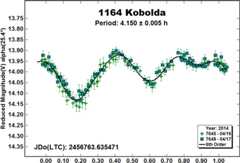
1568 Aisleen (Phocaea).
Malcolm (2001) reported a period of 6.68 h for this asteroid.Hanuset al. (2011) found a sidereal period of 6.67597 h as part of determining a spin axis and shape model. They reported a pole in ecliptic coordinates of (109°, −68°).
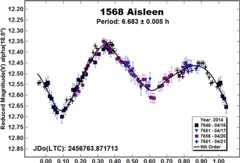
1593 Fagnes (Mars-crosser).
Harriset al. (1992) reported a period of 16.45 h while Lagerkivstet al. (1992) reported 25.1 h. The period spectrum from the 2014 PDS data shows a weak solution near 16.5 h, but – by far – the preferred period is 25.25 hours.


2048 Dwornik (Hungaria).
Dwornik was observed in 2014 as part of an on-going program to obtain sufficient data for spin axis modeling for members of the Hungaria group/family. The 2014 apparition was the fourth one observed by the author (see the references in the LCDB).
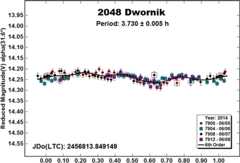
3022 Dobermann (Hungaria).
This is also the fourth apparition that The author observed this particular Hungaria member. Initial modeling using those four data sets indicates a reliable pole solution and retrograde rotation. Details will be in a future paper.
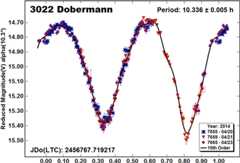
3893 DeLaeter (Phocaea).
The period spectrum using the 2014 PDS data indicates two possible solutions at around 5.5 and 11 hours. The lightcurve plots show the data phased to these solutions. Given the shape of the two, the shorter period is preferred, although the more complex shape of the longer period cannot be formally excluded (seeHarriset al., 2014).
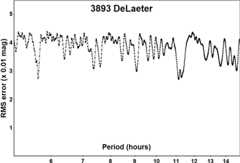

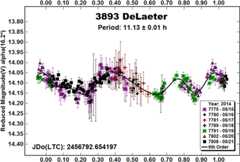
Stephens (2004) reported a period of 13.83 hours, which was not one of the likely solutions in the period spectrum above. His data were available on the MPC lightcurve database site (www.minorplanetcenter.net/light_curve). Even after adjusting zero points in his data, the period did not change substantially and could not be made to fit the periods reported here.
4132 Bartok (Phocaea).
Skiff (2011) andBehrend (2014) both reported periods of about 3.297 h. The PDS period of 3.297 h matches those results.
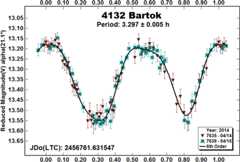
5692 Shirao (Main-belt, middle).
Previous results includeBehrend (2001; 2.90 h),Pray (2005; 2.886 h), and Behrend (2006; 2.90 h). The PDS result of 2.8878 h is in good agreement.
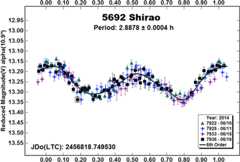
6384 Kervin (Hungaria).
In addition to the 2014 apparition, the author worked this asteroid at three previous apparitions:Warneret al. (2006, 3.6203 h),Warner (2008, 3.647 h) andWarner (2011, 3.617 h). Analysis of the 2014 data set foundP = 3.619 h.
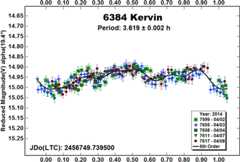
(7247) 1991 TD1 (Hungaria).
The author first worked this asteroid in 2012, reporting a period of 6.3515 h (Warner, 2013b) based on a bimodal lightcurve. Analysis of the data obtained in 2014 found a period of 3.176 h. Forcing the data to the long period resulted in an unlikely quadramodal lightcurve, i.e., one with four minimum/maximum pairs per rotation. The 2012 data were re-examined and found to fit a period of 3.179 hours with a monomodal lightcurve. Given the low amplitude and relatively small phase angle, such a shape is not improbable (seeHarriset al., 2014).
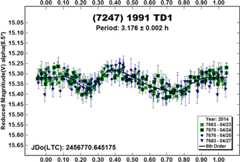
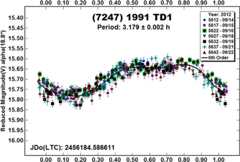
9356 Elineke (Main-belt, middle).
This appears to be the first reported lightcurve for this asteroid.
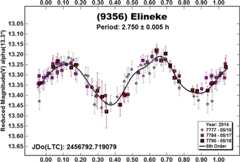
(11279) 1989 TC (Hungaria).
The author first worked 1989 TC in 2010 (Warner, 2011) and reported a period of 4.020 h and amplitudeA = 0.13 mag. Analysis of the data from 2014 produced a period of 4.003 h and amplitude ofA = 0.15 mag. The two periods are statistically the same despite being more than 3-sigma apart. The phase angle bisector longitudes were about 90° apart so, given that the amplitude was about the same both times, it’s probable that the spin axis pole favors one of the ecliptic poles.

(13186) 1996 UM (Hungaria).
A period of 4.304 h was reported by the author based on data obtained in 2013 (Warner, 2013a). The amplitude was 0.69 mag at LPAB ~ 310°. The 2014 data, at LPAB ~ 180°, producedP = 4.293 h andA = 0.37 mag. The diameters going through these two points are at an angle of 50°. Assuming that the viewing aspect in 2013 was nearly equatorial, it is likely that the amplitude would be even lower if LPAB (and north pole of the spin axis) were in the vicinity of 40 ± 20° (or 220 ± 20°).
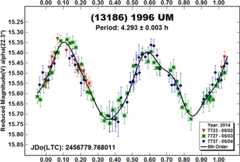
(13245) 1998 MM19 (Hungaria).
Warner (2013c) found a period of 4.664 h. The period derived from the 2014 data is in close agreement. The amplitude at the two apparitions differed by nearly 0.2 mag, indicating that the spin axis is tilted somewhat away from the north or south ecliptic pole.
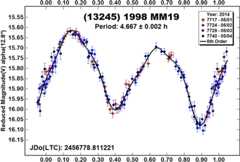
(17633) 1996 JU (Phocaea).
Alberset al. (2010) first reported a period of 6.2098 h. The data from PDS in 2014 produced two periods, one close to Albers (6.20 h) with a bimodal lightcurve and one at the half-period (3.10 h) and a monomodal lightcurve. The amplitude in both cases is on the border for assuming a bimodal lightcurve (seeHarriset al., 2014). There is a significant asymmetry in the Albers lightcurve that supports the 6.20 h solution. The same cannot be said for the PDS data. However, since the period spectrum favors the longer period and it supported by earlier work, the 6.20 h solution is adopted for this work.
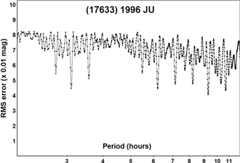
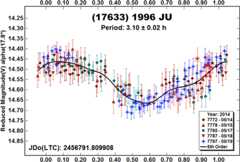
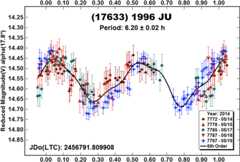
(26227) 1998 HJ7 (Hungaria).
The period spectrum using the PDS 2014 data favors a period of 22 h. There is sufficient asymmetry in the two halves to support this, but the noisy data may be a contributing factor. The shorter period cannot be formally excluded. There were no other results found in the literature.
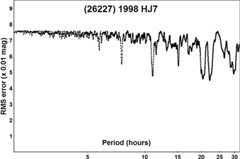
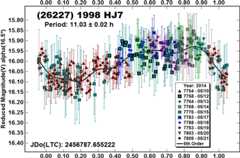
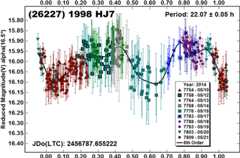
(48470) 1991 TC2 (Hungaria).
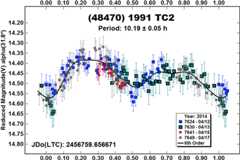
The author first worked 1991 TC2 in 2011 (Warner, 2011). The period was found to be 10.48 h. The data from the 2014 observations produced a period of 10.19 h. Neither data set could be manipulated so that it would fit the period of the other. The amplitude in both cases was 0.19 mag.
(52314) 1991 XD (Hungaria).
The 2014 apparition was the second time the author had observed 1991 XD. The first time (Warner, 2008) a period of 7.663 h was found. Analysis of the 2014 data set foundP = 7.683 h. A second look at the 2007 results found the data (consisting of two consecutive nights in November) better fit a period of 7.676 ± 0.005 h. This is more in line with the 2014 result.
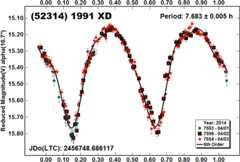
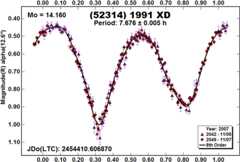
(96155) 1973 HA (Mars-crosser).
This appears to be the first reported lightcurve for 1973 HA.
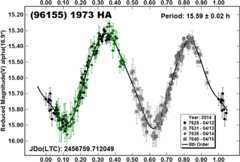
Table II.
Observing circumstances.
| Number | Name | 2014 mm/dd | Pts | Phase | LPAB | BPAB | Period | P.E. | Amp | A.E. |
|---|---|---|---|---|---|---|---|---|---|---|
| 1164 | Kobolda | 04/16–04/17 | 140 | 25.4,25.7 | 165 | 13 | 4.150 | 0.005 | 0.21 | 0.02 |
| 1568 | Aisleen | 04/16–04/21 | 130 | 18.0,17.4 | 245 | 30 | 6.683 | 0.005 | 0.31 | 0.02 |
| 1593 | Fagnes | 05/12–05/27 | 801 | 10.2,13.8 | 232 | 14 | 25.25 | 0.02 | 0.38 | 0.02 |
| 2048 | Dwornik | 06/05–06/08 | 112 | 31.6,31.3 | 313 | 20 | 3.730 | 0.005 | 0.05 | 0.01 |
| 3022 | Dobermann | 04/20–04/23 | 230 | 10.3,11.0 | 207 | 17 | 10.336 | 0.005 | 0.75 | 0.02 |
| 3893 | DeLaeter | 05/15–05/21 | 165 | 16.3,18.8 | 205 | 9 | 5.633 | 0.003 | 0.13 | 0.02 |
| 4132 | Bartok | 04/14–04/15 | 107 | 21.1,21.3 | 158 | −2 | 3.297 | 0.005 | 0.41 | 0.03 |
| 5692 | Shirao | 06/10–06/11 | 181 | 10.9,11.2 | 249 | 16 | 2.8878 | 0.0004 | 0.16 | 0.02 |
| 6384 | Kervin | 04/02–04/07 | 220 | 19.4,18.8 | 204 | 31 | 3.619 | 0.002 | 0.10 | 0.01 |
| 7247 | 1991 TD1 | 1209/14–09/22 | 274 | 18.7,21.1 | 336 | 17 | 3.176 | 0.002 | 0.15 | 0.01 |
| 7247 | 1991 TD1 | 04/23–04/25 | 225 | 8.5,9.6 | 201 | 8 | 3.176 | 0.002 | 0.11 | 0.01 |
| 9356 | Elineke | 05/15–05/18 | 102 | 13.3,14.0 | 209 | 17 | 2.750 | 0.005 | 0.21 | 0.02 |
| 11279 | 1989 TC | 04/16–04/21 | 165 | 17.3,19.8 | 179 | −4 | 4.003 | 0.002 | 0.15 | 0.02 |
| 13186 | 1996 UM | 05/02–05/04 | 100 | 22.3,23.0 | 181 | 1 | 4.293 | 0.003 | 0.37 | 0.02 |
| 13245 | 1998 MM19 | 05/01–05/04 | 140 | 12.8,12.6 | 228 | 17 | 4.667 | 0.002 | 0.47 | 0.02 |
| 17633 | 1996 JU | 05/14–05/19 | 175 | 17.8,0.0,17.7 | 190 | 26 | 6.20A | 0.02 | 0.21 | 0.02 |
| 26227 | 1998 HJ7 | 05/10–05/21 | 330 | 16.6,21.1 | 211 | 19 | 22.07A | 0.05 | 0.15 | 0.03 |
| 48470 | 1991 TC2 | 04/12–04/17 | 186 | 6.5,8.8 | 195 | 6 | 10.19 | 0.05 | 0.19 | 0.02 |
| 52314 | 1991 XD | 04/01–04/03 | 189 | 16.7,16.5 | 194 | 26 | 7.683 | 0.005 | 0.61 | 0.03 |
| 96155 | 1973 HA | 04/12–04/15 | 271 | 16.9,16.9 | 196 | 21 | 15.59 | 0.02 | 0.59 | 0.03 |
Dates in 2012.
preferred period of ambiguous solution.
The phase angle (α) is given at the start and end of each date range, unless it reached a minimum, which is then the second of three values. If a single value is given, the phase angle did not change significantly and the average value is given. LPAB and BPAB are each the average phase angle bisector longitude and latitude, unless two values are given (first/last date in range).
Acknowledgements
Funding for PDS observations, analysis, and publication was provided by NASA grant NNX13AP56G. Work on the asteroid lightcurve database (LCDB) was also funded in part by National Science Foundation Grant AST-1210099. This research was made possible through the use of the AAVSO Photometric All-Sky Survey (APASS), funded by the Robert Martin Ayers Sciences Fund.
References
- Albers K, Kragh K, Monnier A, Pligge Z, Stolze K, West J, Yim A, Ditteon R. (2010). “Asteroid Lightcurve Analysis at the Oakley Southern Sky Observatory: 2009 October thru 2010 April.” Minor Planet Bul37, 152–158. [Google Scholar]
- Behrend R. (2001, 2014). Observatoire de Geneveweb site.http://obswww.unige.ch/~behrend/page_cou.html
- Hanus J, Durech J, Broz M, Warner BD, Pilcher F, Stephens R, Oey J, Bernasconi L, Casulli S, Behrend R, Polishook D, Henych T, Lehký M, Yoshida F, Ito T. (2011). “A study of asteroid pole-latitude distribution based on an extended set of shape models derived by the lightcurve inversion method.” Astron. Astrophys530, A134. [Google Scholar]
- Harris AW, Young JW, Bowell E, Martin LJ, Millis RL, Poutanen M, Scaltriti F, Zappala V, Schober HJ, Debehogne H, Zeigler KW. (1989). “Photoelectric Observations of Asteroids 3, 24, 60, 261, and 863.” Icarus77, 171–186. [Google Scholar]
- Harris AW. Young JW. Dockweiler T, Gibson J, Poutanen M, Bowell E. (1992). “Asteroid lightcurve observations from 1981.” Icarus95, 115–147. [Google Scholar]
- Harris AW, Pravec P, Galad A, Skiff BA, Warner BD, Vilagi J, Gajdos S, Carbognani A, Hornoch K, Kusnirak P, Cooney WR, Gross J, Terrell D, Higgins D, Bowell E, Koehn BW. (2014). “On the maximum amplitude of harmonics on an asteroid lightcurve.” Icarus235, 55–59. [Google Scholar]
- Henden AA, Terrell D, Levine SE, Templeton M, Smith TC, Welch DL. (2009).http://www.aavso.org/apass
- Higgins D, Oey J. (2007). “Asteroid Lightcurve Analysis at Hunters Hill Observatory and Collaborating Stations - December 2006 - April 2007.” Minor Planet Bul34, 79–80. [Google Scholar]
- Higgins D. (2011). “Period Determination of Asteroid Targets Observed at Hunters Hill Observatory: May 2009 - September 2010.” Minor Planet Bul38, 41–46. [Google Scholar]
- Lagerkvist C-I, Magnusson P, Debehogne H, Hoffmann M, Erikson A, de Campos A, Cutispoto G. (1992). “Physical studies of asteroids. XXV - Photoelectric photometry of asteroids obtained at ESO and Hoher List Observatory.” Astron. Astrophys. Suppl. Ser95, 461–470. [Google Scholar]
- Malcolm G. (2001). “Rotational Periods and Lightcurves of 1166 Sakuntala and 1568 Aisleen.” Minor Planet Bul28, 64. [Google Scholar]
- Pravec P, Scheirich P, Durech J, Pollock J, Kusnirak P, Hornoch K, Galad A, Vokrouhlicky D, Harris AW, Jehin E, Manfroid J, Opitom C, Gillon M, Colas F, Oey J, Vrastil J, Reichart D, Ivarsen K, Haislip J, LaCluyze A. (2014). “The tumbling state of (99942) Apophis.” Icarus233, 48–60. [Google Scholar]
- Pray D. (2005). “Lightcurve analysis of asteroids 106, 752, 847, 1057, 1630, 1670, 1927 1936, 2426, 2612, 2647, 4087, 5635, 5692, and 6235.” Minor Planet Bul32, 48–51. [Google Scholar]
- Sauppe J, Torno S, Lemke-Oliver R, Ditteon R. (2007). “Asteroid Lightcurve Analysis at the Oakley Observatory - March/April 2007.” Minor Planet Bul34, 119–122. [Google Scholar]
- Skiff BA. (2011). Posting on CALLweb site.http://www.minorplanet.info/call.html
- Stephens RD. (2004). “Photometry of 683 Lanzia, 1101 Clematis, 1499 Pori, 1507 Vaasa, and 3893 DeLaeter.” Minor Planet Bul31, 4–6. [Google Scholar]
- Warner BD, Pray DP, Pravec P. (2006). “The Lightcurve of Hungaria Asteroid 6384 Kervin.” Minor Planet Bul33, 99. [Google Scholar]
- Warner BD. (2007). “Initial Results of a Dedicated H-G Program.” Minor Planet Bul34, 113–119. [Google Scholar]
- Warner BD. (2008). “Asteroid Lightcurve Analysis at the Palmer Divide Observatory: September-December 2007.” Minor Planet Bul35, 67–71. [PMC free article] [PubMed] [Google Scholar]
- Warner BD. (2008). “Asteroid Lightcurve Analysis at the Palmer Divide Observatory: December 2007 - March 2008.” Minor Planet Bul35, 95–98. [PMC free article] [PubMed] [Google Scholar]
- Warner BD, Harris AW, Pravec P. (2009). “The Asteroid Lightcurve Database.” Icarus202, 134–146. Updates available:http://www.MinorPlanet.info/ [Google Scholar]
- Warner BD. (2011). “Asteroid Lightcurve Analysis at the Palmer Divide Observatory: 2010 September-December.” Minor Planet Bul38, 82–86. [PMC free article] [PubMed] [Google Scholar]
- Warner BD. (2011). “Asteroid Lightcurve Analysis at the Palmer Divide Observatory: 2010 December-2011 March.” Minor Planet Bul38, 142–149. [PMC free article] [PubMed] [Google Scholar]
- Warner BD. (2013a). “Asteroid Lightcurve Analysis at the Palmer Divide Observatory: 2012 June – September.” Minor Planet Bul40, 26–29. [PMC free article] [PubMed] [Google Scholar]
- Warner BD. (2013b). “Rounding Up the Unusual Suspects.” Minor Planet Bul40, 36–42. [PMC free article] [PubMed] [Google Scholar]
- Warner BD. (2013c). “Asteroid Lightcurve Analysis at the Palmer Divide Observatory: 2012 September - 2013 January.” Minor Planet Bul40, 71–80. [PMC free article] [PubMed] [Google Scholar]